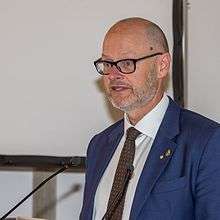Bill S. Hansson

Bill S. Hansson (born 1959) is a Swedish neuroethologist. Since June 5, 2014, he is vice president of the Max Planck Society. [1]
Scientific career
Hansson studied biology at Lund University where he received a Bachelor of Science degree in Biology in 1982. In 1988 he defended his PhD thesis in Ecology. From 1989-90 he worked as postdoc at the University of Arizona and returned 1990 to a junior professorship in Lund. In 1992 he became Associate Professor and from 2000 until 2001 he was a Professor for Chemical Ecology at Lund University (2000). From 2001 he was Professor and Head of the Chemical Ecology department at the Swedish University of Agricultural Sciences (SLU) in Alnarp, Sweden, until he was appointed Director and Scientific Member at the Max Planck Institute for Chemical Ecology in Jena, Germany in 2006. He is head of the Department of Evolutionary Neuroethology.[2] In 2010 the Friedrich Schiller University in Jena appointed him Honorary Professor.
Hansson’s research focuses on neuroethological aspects of insect-insect and insect-plant interactions. He is mainly studying insect olfaction,[3] where his central questions are: How is semiochemical information (odors) detected by the antenna and processed in the insect brain, how did these detection and processing systems evolve, and how does olfaction guide insect behavior?[4][5] He also compares these systems to other land-living arthropods, as the giant robber crab on Christmas Island.[6]
Awards and Honors
- The Takasago International Research Award in Olfactory Science 1998
- International Award of the Jean-Marie Delwart Foundation 2000
- Letterstedt Prize of the Royal Swedish Academy of Sciences 2009
- Fellow of the Saxonian Academy of Sciences 2010
- Fellow of the Royal Swedish Academy of Sciences 2011
- Fellow of the Royal Swedish Academy of Agriculture and Forestry
- Honorary Fellow of the Royal Entomological Society 2011
- Elected member of the Academia Europaea 2012
- Elected member of the Finnish Society of Sciences and Letters 2013[7]
- Silverstein-Simeone Award of the International Society of Chemical Ecology 2014[8]
- International Ellis Island Medal of Honor 2016[9]
Selected Publications
- Hansson, B.S., Christensen, T.A., Hildebrand, J.G,. (1991) .Functionally distinct subdivisions of the macroglomerular complex in the antennal lobe of the male sphinx moth Manduca sexta. Journal of Comparative Neurology, 312(2), 264-278. PMID 1748732
- Hansson, B. S., Ljungberg, H., Hallberg, E., Löfstedt, C. (1992). Functional specialization of olfactory glomeruli in a moth. Science 256:1313-1315. doi:10.1126/science.1598574
- Schiestl, F.P., Ayasse, M., Paulus, H.F., Löfstedt, C., Hansson, B.S., Ibarra, F., Francke, W. (1999). Orchid pollination by sexual swindle. Nature 399:421-422. doi:10.1038/20829
- Hansson, B.S. (Hrsg.) (1999). Insect Olfaction. Springer Verlag, Heidelberg, ISBN 978-3-540-65034-8
- Stensmyr, M. C., Urru, I., Celander, M., Hansson, B.S. (2002). Rotting smell of dead-horse arum florets. Nature, 420, 625-626. doi:10.1038/420625a
- Wicher, D., Schäfer, R., Bauernfeind, R., Stensmyr, M. C., Heller, R., Heinemann, S. H., Hansson, B. S. (2008). Drosophila odorant receptors are both ligand-gated and cyclic-nucleotide-activated cation channels. Nature, 452(7190), 1007-1011. doi:10.1038/nature06861
- Steck, K., Hansson, B. S., Knaden, M. (2009). Smells like home: desert ants, Cataglyphis fortis, use olfactory landmarks to pinpoint the nest. Frontiers in Zoology, 6, 5. doi:10.1186/1742-9994-6-5
- Stökl, J., Strutz, A., Dafni, A., Svatos, A., Doubský, J., Knaden, M., Sachse, S., Hansson, B., Stensmyr, M. C. (2010). A deceptive pollination system targeting drosophilids through olfactory mimicry of yeast. Current Biology, 20, 1846-1852. doi:10.1016/j.cub.2010.09.033
- Grosse-Wilde, E., Kuebler, L., Bucks, S., Vogel, H., Wicher, D., Hansson, B. (2011). Antennal transcriptome of Manduca sexta. Proceedings of the National Academy of Sciences of the United States of America, 108, 7449-7454. doi:10.1073/pnas.1017963108
- Hansson, B., Stensmyr, M. C. (2011). Evolution of insect olfaction. Neuron, 72(5), 698-711. doi:10.1016/j.neuron.2011.11.003
- Stensmyr, M. C., Dweck, H., Farhan, A., Ibba, I., Strutz, A., Mukunda, L., Linz, J., Grabe, V., Steck, K., Lavista Llanos, S., Wicher, D., Sachse, S., Knaden, M., Becher, P. G., Seki, Y., Hansson, B. S. (2012). A conserved dedicated olfactory circuit for detecting harmful microbes in Drosophila. Cell, 151(6), 1345-1357. doi:10.1016/j.cell.2012.09.046
- Dweck, H. K. M., Ebrahim, S. A. M., Kromann, S., Bown, D., Hillbur, Y., Sachse, S., Hansson, B. S., Stensmyr, M.C. (2013). Olfactory Preference for Egg Laying on Citrus Substrates in Drosophila. Current Biology, 23(24), 2472–2480. doi:10.1016/j.cub.2013.10.047
References
- ↑ The team around Martin Stratmann MPG Info, June 5, 2014
- ↑ MPI for Chemical Ecology Website
- ↑ Olfactory Research Is a Precision Business MaxPlanckResearch Magazine 3 /2009
- ↑ Molecular messages from the antennae MPG News, April 15, 2011
- ↑ Fruit Fly Nose Says Steer Clear Of Deadly Food National Public Radio USA, Dec. 6, 2012
- ↑ A Nose for Survival Science Now, Jan. 26, 2005
- ↑ The Finnish Society of Sciences and Letters elected new members on December 16, 2013 Pressmeddelande 17.12.2013, Societas Scientiarum Fennica
- ↑ ISCE Home Page. Retrieved on December 19, 2014.
- ↑ The 2016 Ellis Island Medal of Honor recipients, Web Page of the National Ethnic Coalition of Organizations - NECO. Retrieved on May 19, 2016.
External links
Webpage of the Department of Evolutionary Neuroethology at the Max Planck Institute for Chemical Ecology